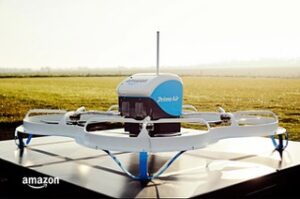E-commerce is no longer new. Online shopping delivered to your doorstep has become a typical millennial lifestyle. The backbone of the e-commerce industry is the transportation and logistics sector. However, one of the biggest challenges for carriers is the timely delivery of orders at the lowest possible cost.
Digitization has helped, providing real-time tracking of goods and mapping the fastest shipping routes. But the logistics sector continues to search for advances and alternative means of transport. Drones are offering one.

Drones are fast, trackable, environmentally friendly and capable of safely and cost-effectively delivering goods to exact locations. They can fly high enough to avoid traffic and low enough not to create a risk to aircraft. Drones have also proven to be the most cost-effective delivery method, giving them a huge advantage in the future of shipping.
In this article, we will explore the concept of drone delivery, evaluating the benefits and challenges as a viable form of shipping.
What are drones?
Drones are unmanned aerial vehicles or aircraft. They are typically robotic quadcopters that can be controlled remotely or operated autonomously using software-based flight plans.
Drones were initially developed for military use to operate as weapons platforms, spy cameras and anti-aircraft targets. They have since found use in a variety of industries and applications, including disaster management, search and rescue, firefighting, surveillance, weather monitoring, agriculture, traffic and infrastructure monitoring, delivery operations, and others.
Drone delivery
Drones used for package delivery are called cargo drones. Amazon was the first company to begin drone delivery in 2013. Others followed suit, including Google, FedEx, UPS and Wal-Mart. Some notable drone delivery companies include Zipline, Google Wing, and Matternet. Drones are used to deliver anything and everything, from consumer goods, groceries and meals to medical supplies and home care products.
Drones do not use fuel but can still travel significant distances, saving shipping costs. These robots are fast, environmentally friendly and profitable. Drones reduce 40-70% of operational costs compared to vehicle delivery services.
During the pandemic, drones proved to be a viable shipping option that offered contactless delivery. Currently, around 20,000 drones are operating for retail deliveries and this number is expected to exceed one million by 2026.
How does drone delivery work?
Typically, when an order is received for shipping, it is packed by a fulfillment warehouse and sent to a shipping center via a vehicle delivery service. Drones are sometimes used next.
From the dispatch center, the drone transports the package (also known as payload) to a specific location via road navigation or the shortest route flight plan. Some companies use a physical dispatch base, while others use mobile vans.
The drone's flight path is managed by GPS-based navigation and may involve remote control by a drone pilot. Drones can fly 16 to 20 km. Ground support is available in the event of a drone error, malfunction (e.g. if the battery runs out) or accident. However, accidents are unlikely because drones are equipped with an anti-collision system. A detection and prevention system typically uses integrated cameras and sonar sensors.
Customers receive a mat marked with QR to identify the delivery location. Upon arrival, the drone lowers the load to the location marked with a QR code. It scans the code to verify location and delivery.
The advantages
The pros of drone delivery include…
1. Faster deliveries: Often the last few miles of delivery are the slowest and most complicated. Traffic and roadworks are the biggest hurdles, as is sometimes finding the right address. Drones can follow the shortest flight path to a location identified by user-supplied GPS coordinates, ensuring accuracy. Drones can fly quickly because there are no speed limits like on roads.
2. Access to remote areas: With drones, making deliveries to remote rural areas or difficult-to-access locations is simple. Unlike vehicle delivery systems, drones are not affected by terrain and can reach locations without roads.
3. Eco-friendly shipping: Drones are battery-powered and do not require fuel. Drone delivery operations reduce carbon emissions and help combat climate change.
4. Profitability: Drones reduce 40 to 70% of operating costs. Besides the cost of the drones, the only additional expenses are electricity (for battery charging) and maintenance.
5. Flexibility. Cargo drones can carry loads weighing up to two tons and transport multiple packages typically delivered by e-commerce and retail operators.
Challenges
Despite launching in 2013, drone technology is still in development. Drones can reach virtually any location, but their flight has a limited range and they are typically only used within the last mile or so of a landing site. In the long term, drone deliveries save money, but initially the setup and implementation costs are high and a deterrent for many logistics companies. Regular maintenance, protocol compliance and ground support are essential and add to company expenses.
Delivery operators must ensure a safe and careful flight plan, which can be challenging when navigating high-rise buildings and certain infrastructure or terrain (such as mountain ranges). Operation also depends on weather conditions. Drones are not ideal for use in rain, snow, or high winds.
Furthermore, it is imperative to ensure that delivery drones are never misused or hacked into something malicious. Drones still lack full public acceptance due to privacy, safety and security concerns.
Another challenge in adopting more drones for retail deliveries is regulation. Drone flights must follow strict protocols regarding licensing, flight routes and safety regulations. And despite the best detection and prevention system, accidents happened.
Drone delivery could be the future of logistics operations, but operators require qualified and experienced drone pilots as well as ground support and maintenance personnel to ensure success.

